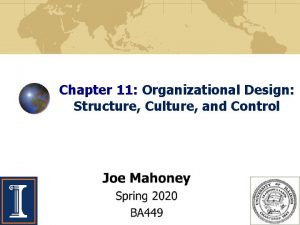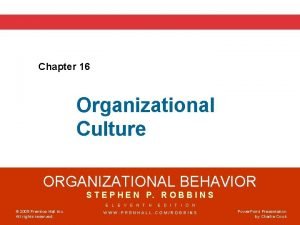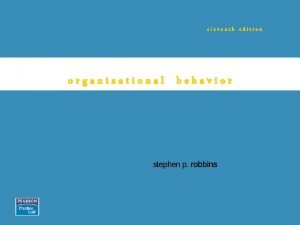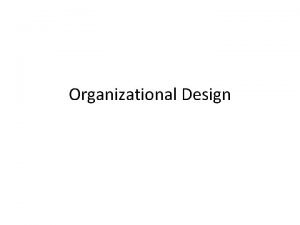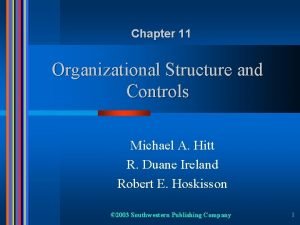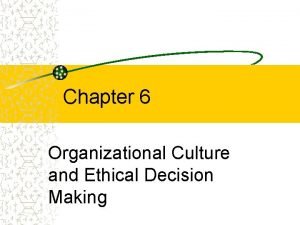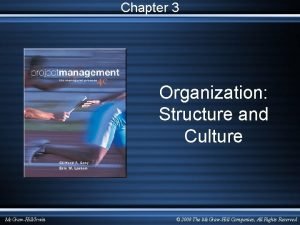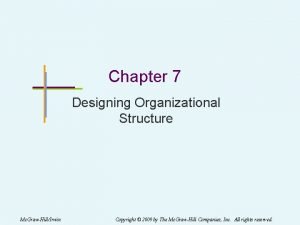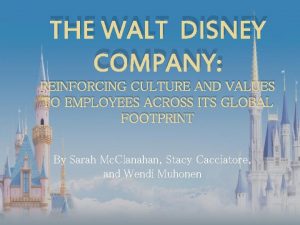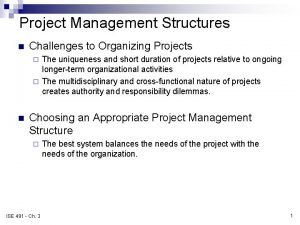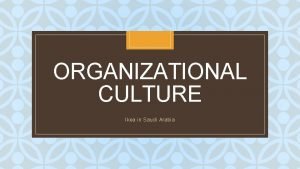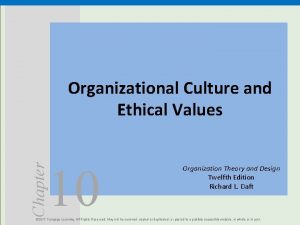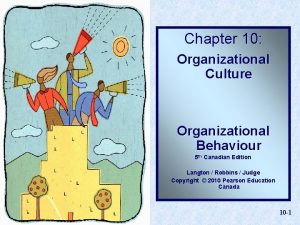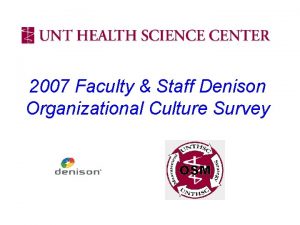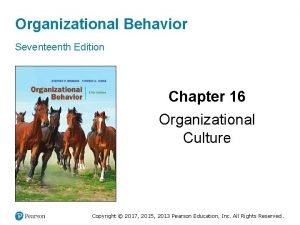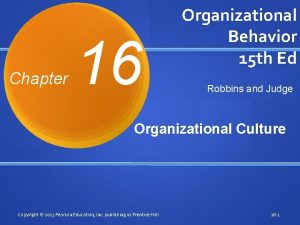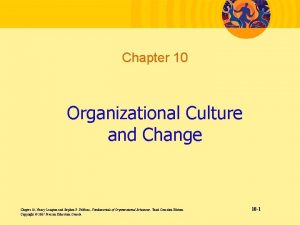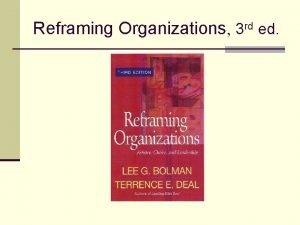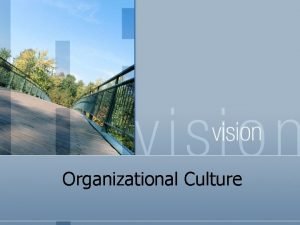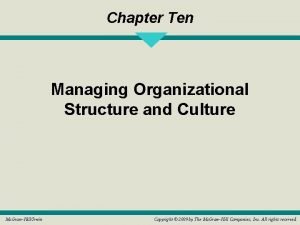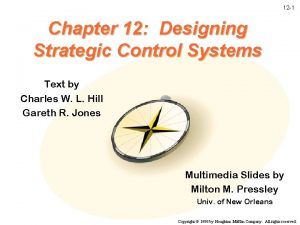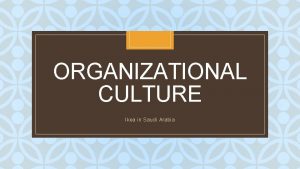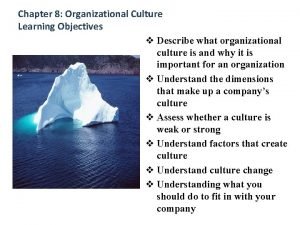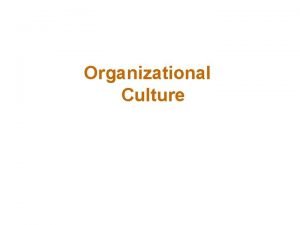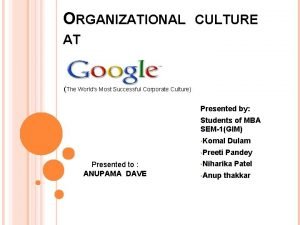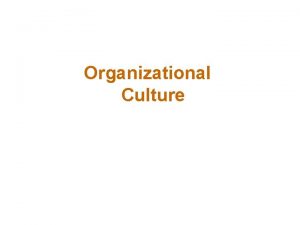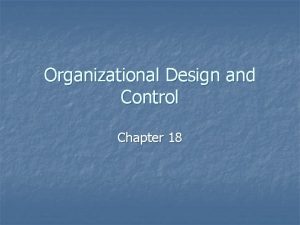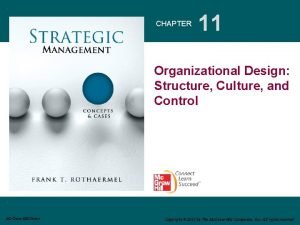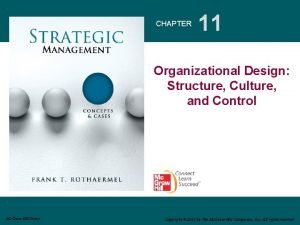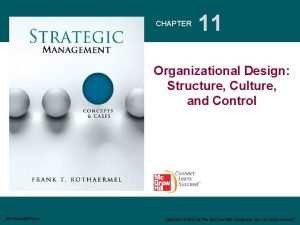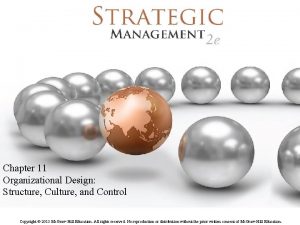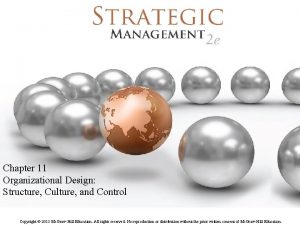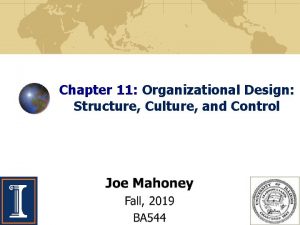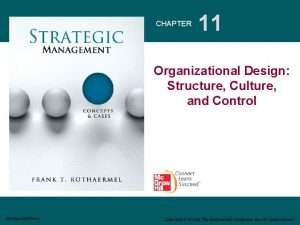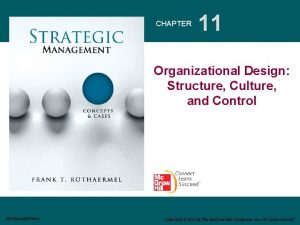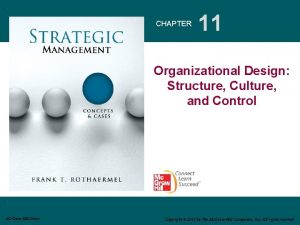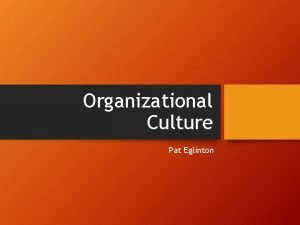Chapter 11 Organizational Design Structure Culture and Control








































- Slides: 40

Chapter 11: Organizational Design: Structure, Culture, and Control

11– 2

How to Organize for Competitive Advantage • Organizational design Ø Structure Ø Processes Ø Procedures • Key components: Ø Structure Ø Culture Ø Control • Structure follows strategy (or inefficiency results) Ø Consider the inefficiency of Pepsi Restaurants overly decentralized structure, which did not follow their related diversification strategy



6 Organizational Inertia • A firm’s resistance to change the status quo • Can lead to the firm’s subsequent failure • The pattern of a firm: – – Mastery of the current environment Success as measured by financial measurements Structures, measures, and systems to manage size Organizational inertia results from shifts in the internal and external environment. Copyright © 2017 by Mc. Graw-Hill Education. This is proprietary material solely for authorized instructor use. Not authorized for sale or distribution in any manner. This document may not be copied, scanned, duplicated, forwarded, distributed, or posted on a website, in whole or part.

The Key Elements of Organizational Structure • Organizational structure determines Ø Work efforts of individuals and teams Ø Resource distribution • Key building blocks Ø Specialization Ø Formalization Ø Centralization Ø Hierarchy

8 Specialization • Describes the degree to which a task is divided into separate jobs (i. e. , the division of labor) • Larger firms: high degree of specialization – Ex: Large-firm accountant might do internal auditing • Smaller ventures: low degree of specialization – Ex: Small-firm accountant might do: • • • Internal auditing Payroll Accounts receivable Financial planning Taxes Copyright © 2017 by Mc. Graw-Hill Education. This is proprietary material solely for authorized instructor use. Not authorized for sale or distribution in any manner. This document may not be copied, scanned, duplicated, forwarded, distributed, or posted on a website, in whole or part.

Formalization • Captures the extent to which employee behavior is steered by explicit and codified rules and procedures • Is not necessarily negative • Often can be necessary for consistent and predictable results – Example. Pilot training – Example. Customer service call centers • Can slow decision making, reduce innovation, and hinder customer service Copyright © 2017 by Mc. Graw-Hill Education. This is proprietary material solely for authorized instructor use. Not authorized for sale or distribution in any manner. This document may not be copied, scanned, duplicated, forwarded, distributed, or posted on a website, in whole or part.

10 Centralization • Refers to the degree to which decision making is concentrated at the top of the organization • Example: BP oil spill in 2010 (Deepwater Horizon) – Decisions made in UK HQ and not on site – Centralization reduced response time and led to a prolonged crisis. • Affects strategic planning: – Top-down strategic planning takes place in highly centralized organizations. – Planned emergence is found in more decentralized organizations. Copyright © 2017 by Mc. Graw-Hill Education. This is proprietary material solely for authorized instructor use. Not authorized for sale or distribution in any manner. This document may not be copied, scanned, duplicated, forwarded, distributed, or posted on a website, in whole or part.

Hierarchy • Determines the formal, position-based reporting lines • Stipulates who reports to whom • Span of control: – The number of employees who directly report to a manager – In tall structures: the span of control is narrow. – In flat structures: the span of control is wide. • Meaning one manager supervises many employees Copyright © 2017 by Mc. Graw-Hill Education. This is proprietary material solely for authorized instructor use. Not authorized for sale or distribution in any manner. This document may not be copied, scanned, duplicated, forwarded, distributed, or posted on a website, in whole or part.

Mechanistic vs. Organic Organizations Exhibit 11. 3 Mechanistic Organizations Specialization Formalization Centralization Hierarchy Organic Organizations • High degree of specialization • Rigid division of labor • Employees focus on narrowly defined tasks • Low degree of specialization • Flexible division of labor • Employees focus on “bigger picture” • Intimate familiarity with rules, policies, and processes necessary • Deep expertise in narrowly defined domain required • Task-specific knowledge valued • Clear understanding of organization’s core competencies and strategic intent • Domain expertise in different areas • Generalized knowledge of how to accomplish strategic goals valued • Decision power centralized at top • Vertical (top-down) communication • Distributed decision making • Vertical (top-down and bottom-up) as well as horizontal communication • • • Flat structures • High span of control • Horizontal as well as two-way vertical communication • Mutual adjustment Tall structures Low span of control Clear lines of authority Command control • Cost-leadership strategy • Differentiation strategy Copyright © 2017 by Mc. Graw-Hill Education. This is proprietary material solely for authorized instructor use. Not authorized • for sale or distribution W. L. Gore, Zappos Business Strategy • Examples: Mc. Donald’s; Walmart Examples: in any manner. This document may not be copied, scanned, duplicated, forwarded, distributed, or posted on a website, in whole or part.

13 W. L. Gore & Associates: Informality and Innovation • Inventor of path-breaking new products – GORE-TEX fabrics, Glide dental floss, and Elixir guitar strings – Devoted to innovation, imagination and initiative – No formal job titles, job descriptions, chains of command, formal communication channels, written rules or standard operating procedures • Uses a boundryless organization form – Everyone is empowered Copyright © 2017 by Mc. Graw-Hill Education. This is proprietary material solely for authorized instructor use. Not authorized for sale or distribution in any manner. This document may not be copied, scanned, duplicated, forwarded, distributed, or posted on a website, in whole or part.

W. L. Gore & Associates: Informality and Innovation • Organized in project-based teams – Led by sponsors, not bosses – Peer control enhances productivity – Group members evaluate each other’s performance • This type of culture has been linked to: – Greater employee satisfaction and retention – Higher personal initiative & creativity – Innovation at the firm level Copyright © 2017 by Mc. Graw-Hill Education. This is proprietary material solely for authorized instructor use. Not authorized for sale or distribution in any manner. This document may not be copied, scanned, duplicated, forwarded, distributed, or posted on a website, in whole or part.

15 Firm Strategy and Structure • Are interdependent • Impact a firm’s performance • Changes over time as the firm grow in: – Size and complexity • Successful new ventures generally grow: – First by increasing sales – Then by obtaining larger geographic reach – Finally by diversifying • Through vertical integration • Entering into related and unrelated businesses Copyright © 2017 by Mc. Graw-Hill Education. This is proprietary material solely for authorized instructor use. Not authorized for sale or distribution in any manner. This document may not be copied, scanned, duplicated, forwarded, distributed, or posted on a website, in whole or part.

Types of Organizational Structure Exhibit 11. 4 • Simple • Functional • Multidivisional • Matrix Copyright © 2017 by Mc. Graw-Hill Education. This is proprietary material solely for authorized instructor use. Not authorized for sale or distribution in any manner. This document may not be copied, scanned, duplicated, forwarded, distributed, or posted on a website, in whole or part.

17 Simple Structure • Generally used by small firms with low organizational complexity • Founders make all the strategic decisions. • Founders run day-to-day operations. • Professional managers/sophisticated systems are not usually in place. Copyright © 2017 by Mc. Graw-Hill Education. This is proprietary material solely for authorized instructor use. Not authorized for sale or distribution in any manner. This document may not be copied, scanned, duplicated, forwarded, distributed, or posted on a website, in whole or part.

Functional Structure • Employees are grouped into functional areas. – Based on domain expertise – Often correspond to distinct stages in the value chain • R&D, engineering, manufacturing, marketing and sales • Supporting areas such as HR, finance, and accounting • Leaders of functional areas report to the CEO. • Influenced by strategy: – Cost leadership: Mechanistic organization – Differentiation: Organic organization – Blue ocean: Ambidextrous organization Copyright © 2017 by Mc. Graw-Hill Education. This is proprietary material solely for authorized instructor use. Not authorized for sale or distribution in any manner. This document may not be copied, scanned, duplicated, forwarded, distributed, or posted on a website, in whole or part.

Typical Functional Structure Exhibit 11. 5 Copyright © 2017 by Mc. Graw-Hill Education. This is proprietary material solely for authorized instructor use. Not authorized for sale or distribution in any manner. This document may not be copied, scanned, duplicated, forwarded, distributed, or posted on a website, in whole or part.

20 Disadvantages of Functional Structure • Frequently lacks effective communication channels across departments. • The top-level manager must take on the coordination and integration work. • It cannot effectively address a higher level of diversification, which often stems from further growth. Copyright © 2017 by Mc. Graw-Hill Education. This is proprietary material solely for authorized instructor use. Not authorized for sale or distribution in any manner. This document may not be copied, scanned, duplicated, forwarded, distributed, or posted on a website, in whole or part.

Multidivisional Structure • Consists of several distinct strategic business units (SBUs) – Each with its own profit-and-loss (P&L) responsibility • Each SBU is operated (quasi-)independently. • Each is led by a divisional manager – Responsible for the unit’s business strategy – Responsible for day-to-day operations Copyright © 2017 by Mc. Graw-Hill Education. This is proprietary material solely for authorized instructor use. Not authorized for sale or distribution in any manner. This document may not be copied, scanned, duplicated, forwarded, distributed, or posted on a website, in whole or part.

Organizing the Diversified Firm • The multidivisional organization, as documented by Alfred D. Chandler in Strategy and Structure, was pioneered in the 1920 s by pioneering firms such as: Ø Du. Pont, General Motors, Sears and Standard Oil; Ø By 1967, two-thirds of Fortune 500 Companies are multidivisional.


Organizing the Diversified Firm • Three key features of organizational structure: Ø 1. The division of tasks; Ø 2. The depth of the hierarchy (span of control); Ø 3. The extent of authority delegation (how much decentralization? ) 11– 24


26 Business Strategy and Multidivisional Structure • Related Diversification – Cooperative M-Form • Centralized decision making • High level of integration at corporate headquarters • Co-opetition among SBUs • Unrelated Diversification – Competitive M-Form • Decentralized decision making • Low level of integration at corporate headquarters • Competition among SBUs for resources Copyright © 2017 by Mc. Graw-Hill Education. This is proprietary material solely for authorized instructor use. Not authorized for sale or distribution in any manner. This document may not be copied, scanned, duplicated, forwarded, distributed, or posted on a website, in whole or part.

11– 27

11– 28

Evolutionary Stability of the Multidivisional Form • Parable of the Two Watchmakers Ø 10, 000 parts v Watchmaker #1 needs to put all parts together or the watch falls apart and he needs to start all over with his 10, 000 parts. v Watchmaker #2 has developed 100 subsystems of 100 parts. This is the “principle of near-decomposability” (I. e. , a system that contains localized sub-systems)

Evolutionary Stability of the Multidivisional Form • Hierarchical systems (containing sub-systems) will evolve much more rapidly from elementary constituents than will non-hierarchic systems containing the same number of elements. • In organization theory this is called the effectiveness of “loose coupling. ” Ø The advantage of “loose coupling” is that if there is poor performance in division 2 it does not lead to failure of the entire system. 11– 30

Effectiveness of Multidivisional Form • Effective Divisionalization involves: Ø Identification of separable economic activities within the firm; Ø Giving quasi-autonomous standing to each division (usually of a profit center nature); Ø Monitoring the efficiency performance of each division; Ø Awarding incentives; Ø Allocating cash flow to high yield uses; and Ø Performing strategic planning (diversification, acquisition, and related activities). 11– 31

Disadvantages of the Multidivisional Structure • Dysfunctional Aspects of the Multidivisional: Ø Emphasis on short-term perspective; Ø Loss of economies of scope; Ø Duplication of R&D, marketing, etc. ; Ø Divisions can end up (dysfunctionally competing with each other; e. g. , Pepsi Restaurants) Ø Emphasis on financial manipulation instead of developing firm capabilities and resources; Ø Large conglomerates may have excessive political power.

33 Matrix Structure • Firm is organized according to SBUs – Like in the M-form • Also has a second dimension of organizational structure – Consists of different geographic areas • Purpose: – Combine the benefits of the M-form • Domain expertise, economies of scale, and the efficient processing of information – With benefits of the functional structure • Responsiveness and decentralized focus Copyright © 2017 by Mc. Graw-Hill Education. This is proprietary material solely for authorized instructor use. Not authorized for sale or distribution in any manner. This document may not be copied, scanned, duplicated, forwarded, distributed, or posted on a website, in whole or part.

Typical (Global) Matrix Structure Exhibit 11. 9 Copyright © 2017 by Mc. Graw-Hill Education. This is proprietary material solely for authorized instructor use. Not authorized for sale or distribution in any manner. This document may not be copied, scanned, duplicated, forwarded, distributed, or posted on a website, in whole or part.

Matching Global Strategy and Structure



38 Where Do Organizational Cultures Come From? • Founder imprinting – The founder defines and shapes the culture. – Can persist for decades after his or her departure – Examples: Steve Jobs (Apple), Walt Disney (Disney), Sergey Brin & Larry Page (Google), Michael Dell (Dell), Oprah Winfrey (Harpo), Martha Stewart (Living Omnimedia), Bill Gates (Microsoft), Larry Ellison (Oracle), Herb Kelleher (Southwest Airlines), and Sam Walton (Wal-mart) • Groupthink – When opinions combine – Results when individuals do not critically evaluate and challenge a leader’s opinions and assumptions Copyright © 2017 by Mc. Graw-Hill Education. This is proprietary material solely for authorized instructor use. Not authorized for sale or distribution in any manner. This document may not be copied, scanned, duplicated, forwarded, distributed, or posted on a website, in whole or part.

How Does Organizational Culture Change? • Culture can turn from core competencies into core rigidities (e. g. , GM’s bureaucratic culture). • A firm must hone, refine, and upgrade. – Because the firm and the environment change • The primary means of cultural change: – The board of directors brings in new leadership. – Leadership is charged to make changes in strategy and structure. • Culture is shaped through: – Organizational structure – Resource allocation and reward systems Copyright © 2017 by Mc. Graw-Hill Education. This is proprietary material solely for authorized instructor use. Not authorized for sale or distribution in any manner. This document may not be copied, scanned, duplicated, forwarded, distributed, or posted on a website, in whole or part.

40 Organizational Culture and Competitive Advantage • Can organizational culture can help a firm gain and sustain competitive advantage? Yes, IF: – The culture makes a positive contribution to the firm’s economic value creation. – If the culture follows the VRIO(N) principles • It can be an effective lever for new ventures: – It is malleable. – Firm founders, early-stage CEOs, and venture capitalists should be proactive: • Create a culture that supports a firm’s economic value creation Copyright © 2017 by Mc. Graw-Hill Education. This is proprietary material solely for authorized instructor use. Not authorized for sale or distribution in any manner. This document may not be copied, scanned, duplicated, forwarded, distributed, or posted on a website, in whole or part.
 Organizational design: structure, culture, and control
Organizational design: structure, culture, and control Customer responsive culture
Customer responsive culture Customer responsive culture examples
Customer responsive culture examples Organizational structure and design
Organizational structure and design Mixed departmentalization
Mixed departmentalization Sbu m-form structure
Sbu m-form structure The role of corporate culture in ethical decision making
The role of corporate culture in ethical decision making Organizational culture diagnosis worksheet
Organizational culture diagnosis worksheet Material culture example
Material culture example Continuous culture and batch culture
Continuous culture and batch culture American vs indian culture
American vs indian culture Stroke culture method
Stroke culture method Folk culture and popular culture venn diagram
Folk culture and popular culture venn diagram How does popular culture diffuse
How does popular culture diffuse Indole test
Indole test Homework due today
Homework due today Stab culture and stroke culture
Stab culture and stroke culture Carpet culture method
Carpet culture method Surface culture deep culture and esol
Surface culture deep culture and esol Split range
Split range Chapter 7 designing organizational structure
Chapter 7 designing organizational structure Chapter 7 designing organizational structure
Chapter 7 designing organizational structure Disney company value
Disney company value Organizational culture diagnosis worksheet
Organizational culture diagnosis worksheet Organizational culture of ikea
Organizational culture of ikea Adaptive culture from inert culture
Adaptive culture from inert culture Organizational culture aspects
Organizational culture aspects Characteristics of organizational culture
Characteristics of organizational culture Denison organizational culture survey
Denison organizational culture survey Whats organizational culture
Whats organizational culture Organizational cultures often reflect national culture.
Organizational cultures often reflect national culture. Robbins organizational culture
Robbins organizational culture Characteristics of organizational culture
Characteristics of organizational culture Reframing organizational culture
Reframing organizational culture Organizational culture inventory
Organizational culture inventory Inert organizational culture
Inert organizational culture Inert organizational culture
Inert organizational culture Ikea corporate culture
Ikea corporate culture Organizational culture is related to the polc function of:
Organizational culture is related to the polc function of: Institutionalization organizational culture
Institutionalization organizational culture Google organizational culture
Google organizational culture
